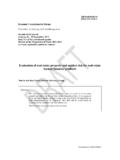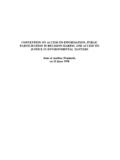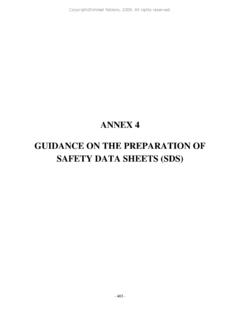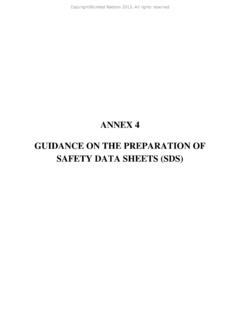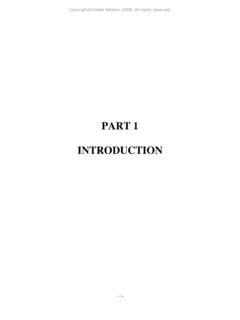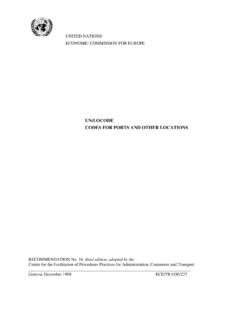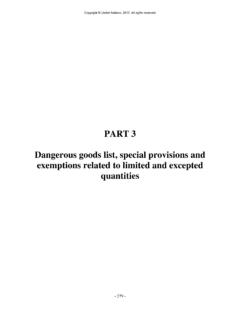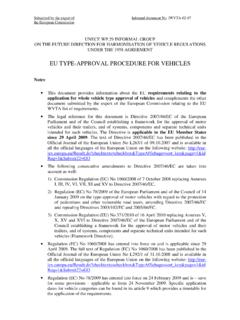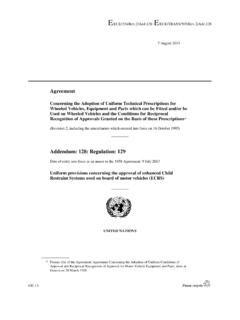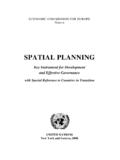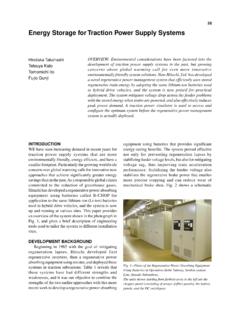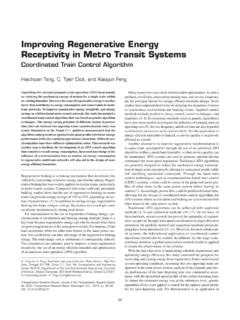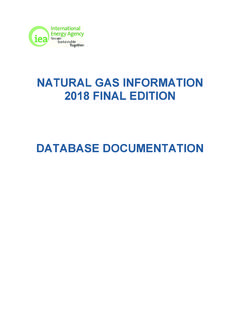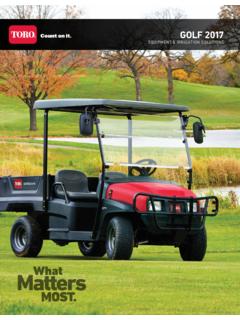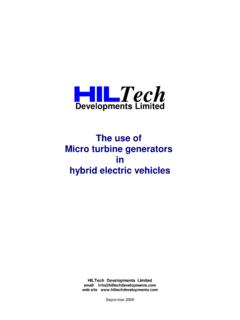Transcription of Agreement - unece.org
1 Agreement Concerning the Adoption of Harmonized Technical United Nations Regulations for Wheeled Vehicles, Equipment and Parts which can be Fitted and/or be Used on Wheeled Vehicles and the Conditions for Reciprocal Recognition of Approvals Granted on the Basis of these United Nations Regulations* (Revision 3, including the amendments which entered into force on 14 September 2017) Addendum 12-H: UN Regulation No. 13-H Revision 4 Incorporating all valid text up to: Supplement 16 to the original version of the Regulation Date of entry into force: 15 June 2015 01 series of amendments Date of entry into force: 9 February 2017 Uniform provisions concerning the approval of passenger cars with regard to braking This document is meant purely as documentation tool. The authentic and legal binding texts are: ECE/ and ECE/ _____ UNITED NATIONS * Former titles of the Agreement : Agreement concerning the Adoption of Uniform Conditions of Approval and Reciprocal Recognition of Approval for Motor Vehicle Equipment and Parts, done at Geneva on 20 March 1958 (original version); Agreement concerning the Adoption of Uniform Technical Prescriptions for Wheeled Vehicles, Equipment and Parts which can be Fitted and/or be Used on Wheeled Vehicles and the Conditions for Reciprocal Recognition of Approvals Granted on the Basis of these Prescriptions, done at Geneva on 5 October 1995 (Revision 2).
2 E/ECE/324 E/ECE/TRANS/505 5 June 2018 E/ECE/324 E/ECE/TRANS/505 3 UN Regulation No. 13-H Uniform provisions concerning the approval of passenger cars with regard to braking Contents Page Regulation 1. Scope .. 5 2. Definitions .. 5 3. Application for approval .. 8 4. Approval .. 8 5. Specifications .. 9 6. Tests .. 22 7. Modification of vehicle type or braking system and extension of approval .. 22 8. Conformity of production .. 23 9. Penalties for non-conformity of production .. 23 10. Production definitively discontinued .. 23 11. Names and addresses of Technical Services responsible for conducting approval tests, and of Type Approval Authorities .. 23 12. Transitional provisions .. 24 Annexes 1 Communication .. 26 Appendix - List of vehicle data for the purpose of UN Regulation No.
3 90 approvals .. 28 2 Arrangements of approval marks .. 30 3 Braking tests and performance of braking systems .. 31 Appendix - Procedure for monitoring the state of battery charge .. 39 4 Provisions relating to energy sources and energy storage devices (energy accumulators) .. 40 5 Distribution of braking among the axles of vehicles .. 42 Appendix 1 - Wheel-lock sequence test procedure .. 45 Appendix 2 - Torque wheel test procedure .. 47 6 Test requirements for vehicles fitted with anti-lock systems .. 50 Appendix 1 - Symbols and definitions .. 56 Appendix 2 - Utilisation of adhesion .. 58 Appendix 3 - Performance on differing adhesion surfaces .. 61 Appendix 4 - Method of selection of the low adhesion surface .. 62 E/ECE/324 E/ECE/TRANS/505 4 7 Inertia dynamometer test method for brake linings.
4 63 8 Special requirements to be applied to the safety aspects of complex electronic vehicle control systems .. 66 E/ECE/324 E/ECE/TRANS/505 5 1. Scope This Regulation applies to the braking of vehicles of categories M1 and This Regulation does not cover: Vehicles with a design speed not exceeding 25 km/h; Vehicles fitted for invalid drivers; The approval of the Electronic Stability Control (ESC) and Brake Assist System(s) (BAS) of the vehicle. 2. Definitions For the purposes of this Regulation, "Approval of a vehicle" means the approval of a vehicle type with regard to braking. "Vehicle type" means a category of vehicles which do not differ in such essential respects as: The maximum mass, as defined in paragraph below; The distribution of mass among the axles; The maximum design speed; A different type of braking equipment, with more particular reference to the presence or otherwise of equipment for braking a trailer or any presence of electric braking system; The engine type; The number and ratios of gears; The final drive ratios; The tyre dimensions.
5 "Braking equipment" means the combination of parts whose function is progressively to reduce the speed of a moving vehicle or bring it to a halt, or to keep it stationary if it is already halted; these functions are specified in paragraph below. The equipment consists of the control, the transmission, and the brake proper. "Control" means the part actuated directly by the driver to furnish to the transmission the energy required for braking or controlling it. This energy may be the muscular energy of the driver, or energy from another source controlled by the driver, or a combination of these various kinds of energy. 1 This Regulation offers an alternative set of requirements for category N1 vehicles to those contained in UN Regulation No.
6 13. Contracting Parties that apply both UN Regulation No. 13 and this Regulation recognize approvals to either Regulation as equally valid. M1 and N1 categories of vehicles are defined in the Consolidated Resolution on the Construction of Vehicles ( ), document ECE/ , para. 2 - E/ECE/324 E/ECE/TRANS/505 6 "Transmission" means the combination of components comprised between the control and the brake and linking them functionally. The transmission may be mechanical, hydraulic, pneumatic, electric or mixed. Where the braking power is derived from or assisted by a source of energy independent of the driver, the reserve of energy in the system is likewise part of the transmission. The transmission is divided into two independent functions: the control transmission and the energy transmission.
7 Whenever the term "transmission" is used alone in this Regulation, it means both the "control transmission" and the "energy transmission": "Control transmission" means the combination of the components of the transmission which control the operation of the brakes, including the control function and the necessary reserve(s) of energy; "Energy transmission" means the combination of the components which supply to the brakes the necessary energy for their function, including the reserve(s) of energy necessary for the operation of the brakes. "Brake" means the part in which the forces opposing the movement of the vehicle develop. It may be a friction brake (when the forces are generated by friction between two parts of the vehicle moving relatively to one another); an electrical brake (when the forces are generated by electro-magnetic action between two parts of the vehicle moving relatively to but not in contact with one another); a fluid brake (when the forces are generated by the action of a fluid situated between two parts of the vehicle moving relatively to one another); or an engine brake (when the forces are derived from an artificial increase in the braking action, transmitted to the wheels, of the engine).
8 "Different types of braking equipment" means equipment which differ in such essential respects as: Components having different characteristics; A component made of materials having different characteristics, or a component differing in shape or size; A different assembly of the components. "Component of the braking equipment" means one of the individual parts which, when assembled, constitutes the braking equipment. "Progressive and graduated braking" means braking during which, within the normal operating range of the device, and during actuation of the brakes (see paragraph below): The driver can at any moment increase or decrease the braking force by acting on the control; The braking force varies proportionally as the action on the control (monotonic function); The braking force can be easily regulated with sufficient precision.
9 "Laden vehicle" means, except where otherwise stated, a vehicle so laden as to attain its "maximum mass". "Maximum mass" means the maximum mass stated by the vehicle manufacturer to be technically permissible (this mass may be higher than the "permissible maximum mass" laid down by the national administration). E/ECE/324 E/ECE/TRANS/505 7 "The distribution of mass among the axles" means the distribution of the effect of the gravity on the mass of the vehicle and/or its contents among the axles. "Wheel/axle load" means the vertical static reaction (force) of the road surface in the contact area on the wheel/wheels of the axle. "Maximum stationary wheel/axle load" means the stationary wheel/axle load achieved under the condition of the laden vehicle.
10 "Hydraulic braking equipment with stored energy" means a braking equipment where energy is supplied by a hydraulic fluid under pressure, stored in one or more accumulator(s) fed from one or more pressure pump(s), each fitted with a means of limiting the pressure to a maximum value. This value shall be specified by the manufacturer. "Actuation" means both application and release of the control. "Electric regenerative braking" means a braking system which, during deceleration, provides for the conversion of vehicle kinetic energy into electrical energy. "Electric regenerative braking control" means a device which modulates the action of the electric regenerative braking system; "Electric regenerative braking system of category A" means an electric regenerative braking system which is not part of the service braking system; "Electric regenerative braking system of category B" means an electric regenerative braking system which is part of the service braking system; "Electric state of charge" means the instantaneous ratio of electric quantity of energy stored in the traction battery relative to the maximum quantity of electric energy which could be stored in this battery.
